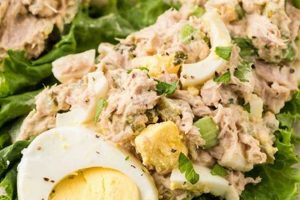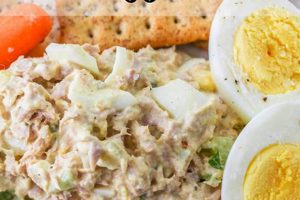This dish combines the classic elements of egg salad chopped hard-boiled eggs, seasonings, and often vegetables with the creamy tang of Greek yogurt. A typical preparation involves blending mashed or chopped eggs with Greek yogurt, mustard, herbs, and optional additions like celery, onion, or relish. This creates a lighter, protein-rich alternative to traditional mayonnaise-based egg salad.
Using Greek yogurt offers several advantages. Its lower fat and calorie content compared to mayonnaise makes it a healthier option. The higher protein content contributes to satiety, and the tangy flavor adds a refreshing twist. This adaptation aligns with contemporary trends toward healthier eating and exploring variations on classic recipes. It offers a simple way to increase protein intake while enjoying a familiar and versatile dish.
The following sections will explore specific ingredient variations, detailed preparation methods, nutritional information, and serving suggestions for incorporating this healthier egg salad into different meals.
Tips for a Superior Egg Salad with Greek Yogurt
Achieving optimal flavor and texture requires attention to several key details. The following tips offer guidance for creating a truly exceptional egg salad.
Tip 1: Perfect Hard-Boiled Eggs: Overcooked yolks can result in a dry, crumbly texture. Aim for a firm, yet creamy yolk by using a gentle cooking method. Once boiling, remove the eggs from heat, cover, and let them sit for 10-12 minutes depending on size. Immediately transfer to an ice bath to stop cooking and ensure easy peeling.
Tip 2: Greek Yogurt Selection: Plain, non-fat Greek yogurt provides the cleanest flavor profile and allows for greater control over seasoning. Full-fat Greek yogurt can be used for a richer, creamier texture.
Tip 3: Enhancing Flavor: Dijon mustard provides a classic tang. Fresh herbs, such as dill, chives, or parsley, add brightness. Experiment with spices like paprika or cayenne pepper for depth.
Tip 4: Texture Control: For a smoother egg salad, finely chop or mash the eggs. For a chunkier texture, coarsely chop the eggs. The amount of Greek yogurt used also influences the final consistency.
Tip 5: Incorporating Vegetables: Finely diced celery and red onion offer a classic crunch and flavor contrast. Consider additions like chopped bell peppers or water chestnuts for variety.
Tip 6: Seasoning Balance: Seasoning should be adjusted to taste. Start with a small amount of salt and pepper and gradually increase until the desired flavor is reached. Taste and adjust seasonings after chilling, as flavors can meld and intensify.
Tip 7: Chilling Time: Allow the egg salad to chill for at least 30 minutes before serving. Chilling enhances the flavors and allows the ingredients to meld.
By following these guidelines, one can create an egg salad that is both flavorful and healthful. Attention to these details ensures a consistently satisfying and nutritious dish.
These techniques provide a foundation for creating a personalized egg salad recipe tailored to individual preferences. The following section provides additional serving suggestions and variations.
1. Ingredient Quality
Ingredient quality significantly impacts the overall flavor, texture, and nutritional value of egg salad made with Greek yogurt. Fresh, high-quality eggs contribute a clean taste and desirable texture. Their yolks should be a vibrant yellow and possess a smooth, creamy consistency. Substandard eggs can impart off-flavors or result in a dry, crumbly texture. Similarly, the quality of the Greek yogurt plays a crucial role. Selecting a fresh, reputable brand ensures a smooth, creamy base with a pleasant tang. Low-quality yogurt can have a watery consistency or an undesirable aftertaste, negatively affecting the final product. Opting for organic or free-range eggs and yogurt from grass-fed cows can further enhance the nutritional profile and flavor.
The importance of ingredient quality extends beyond the primary components. Fresh herbs, such as dill or chives, contribute a bright, vibrant flavor that elevates the dish. Wilted or dried herbs lack the same potency and can introduce an unpleasant bitterness. Similarly, using fresh, crisp vegetables like celery or red onion enhances the textural complexity and adds a refreshing element. Limp or decaying vegetables detract from the overall sensory experience. Even seemingly minor ingredients, such as mustard or spices, benefit from careful selection. High-quality Dijon mustard provides a complex tang, while freshly ground spices offer a more nuanced flavor profile.
Prioritizing ingredient quality ensures a superior egg salad experience. The investment in fresh, high-quality components yields a noticeable difference in taste, texture, and nutritional value. This understanding empowers individuals to make informed choices that result in a healthier and more satisfying culinary outcome. While cost may be a factor, the benefits of using superior ingredients often outweigh the marginal price difference, particularly considering the potential health implications of consuming lower-quality, processed alternatives.
2. Yogurt Selection
Yogurt selection significantly influences the final character of egg salad incorporating Greek yogurt. The choice affects not only the nutritional profile but also the texture, flavor, and overall palatability. Different types of Greek yogurt offer varying levels of fat, impacting the richness and creaminess of the salad. Non-fat Greek yogurt creates a lighter, tangier egg salad, ideal for those seeking a lower-calorie option. Full-fat Greek yogurt, conversely, yields a richer, creamier texture, more closely resembling traditional mayonnaise-based versions. The fat content also affects mouthfeel and satiety. Higher fat content contributes to a more luxurious texture and can promote a greater sense of fullness. This allows for portion control and potentially supports weight management goals.
Beyond fat content, flavor profiles also vary. Plain, unflavored Greek yogurt offers a neutral base, allowing the flavors of other ingredients, such as herbs and spices, to shine through. Flavored varieties, while convenient, can sometimes clash with or overpower the delicate flavors of the egg salad. Added sugars or artificial sweeteners in some flavored yogurts can also detract from the nutritional benefits. Selecting plain Greek yogurt empowers control over the final flavor profile, facilitating customization based on individual preferences. For instance, a plain base allows for the incorporation of fresh herbs, spices, or a touch of honey or maple syrup for sweetness, offering greater flexibility and control over the final product.
Careful yogurt selection thus presents an opportunity to tailor the egg salad to specific dietary needs and taste preferences. Understanding the impact of fat content and flavor profiles facilitates informed decision-making. Choosing the appropriate Greek yogurt enhances not only the sensory experience but also the nutritional value of this versatile dish. This understanding empowers individuals to create a healthier and more enjoyable version of a classic recipe.
3. Flavor Balance
Flavor balance is paramount in creating a successful egg salad with Greek yogurt. The inherent tang of Greek yogurt necessitates careful consideration of complementary and contrasting flavors to achieve a harmonious and palatable final product. A well-balanced egg salad avoids extremes of sweetness, saltiness, acidity, or bitterness, offering a complex and nuanced flavor profile.
- Acidity:
The tanginess of Greek yogurt provides a natural acidity. This can be enhanced with ingredients like lemon juice or vinegar, but requires balance. Too much acidity can make the salad sharp and unappealing. A small amount of sweetness, from a touch of honey or finely diced apple, can temper excessive acidity and create a more rounded flavor profile.
- Saltiness:
Salt enhances the flavors of the other ingredients. However, excessive salt can overpower the delicate egg and yogurt flavors. Start with a small amount of salt and gradually add more, tasting frequently, until the desired level of saltiness is achieved. The saltiness of other ingredients, such as pickles or capers, should also be considered when determining the overall salt level.
- Savory Notes:
Savory notes provide depth and complexity. These can be achieved through the use of ingredients like Dijon mustard, chives, or black pepper. Mustard adds a pungent, slightly bitter note that complements the richness of the eggs and the tang of the yogurt. Chives contribute a mild onion flavor, while black pepper provides a subtle heat. The balance of these savory elements prevents the salad from tasting bland or one-dimensional.
- Textural Contrast:
While not strictly a flavor element, texture plays a role in perceived flavor balance. The creamy base of the egg salad benefits from textural contrast. This can be achieved through the addition of finely diced celery, red onion, or chopped walnuts. These ingredients add a satisfying crunch and prevent the salad from becoming overly smooth and monotonous. The interplay of textures enhances the overall sensory experience.
Successfully balancing these flavor components results in an egg salad that is not only delicious but also highlights the distinct qualities of Greek yogurt. A harmonious flavor profile elevates the dish beyond a simple combination of ingredients, transforming it into a nuanced and satisfying culinary experience. This attention to flavor balance exemplifies how thoughtful ingredient selection and preparation can significantly impact the enjoyment of even seemingly basic recipes.
4. Texture
Texture plays a crucial role in the overall enjoyment of egg salad made with Greek yogurt. The interplay of creamy, smooth, and crunchy elements contributes significantly to the sensory experience. Greek yogurt itself possesses a naturally creamy texture, which serves as the foundation of the dish. The consistency of the yogurt, influenced by its fat content, directly impacts the final texture of the egg salad. A higher fat content results in a richer, denser texture, while a lower fat content yields a lighter, more airy consistency. The size of the egg pieces also affects the texture. Finely chopped eggs create a smoother, more uniform texture, while coarsely chopped eggs introduce a more substantial, chunkier element.
The incorporation of additional ingredients further influences the textural complexity. Finely diced vegetables, such as celery, red onion, or bell peppers, introduce a crisp, contrasting element to the creamy base. The subtle crunch of these vegetables adds a refreshing dimension and prevents the salad from becoming overly homogenous. Similarly, the addition of chopped nuts, seeds, or dried cranberries can provide textural variation and enhance the overall sensory experience. The choice of bread or vessel for serving also contributes to the overall textural profile. A crusty baguette offers a substantial contrast to the creamy filling, while a delicate croissant provides a softer, more yielding counterpoint.
Understanding the interplay of these textural elements allows for the creation of an egg salad tailored to individual preferences. Whether one prefers a smooth, uniform texture or a more substantial, varied experience, careful consideration of ingredient preparation and selection enables the creation of a perfectly balanced and satisfying egg salad. Achieving the desired texture enhances not only the enjoyment of the dish but also its perceived flavor and overall quality. This attention to detail elevates the egg salad from a simple combination of ingredients to a more refined and nuanced culinary creation.
5. Nutritional Value
Nutritional value represents a significant advantage of egg salad incorporating Greek yogurt compared to traditional mayonnaise-based versions. The substitution of Greek yogurt for mayonnaise drastically reduces fat and calorie content while simultaneously increasing protein. This shift offers a more nutrient-dense option, aligning with contemporary health-conscious dietary trends. Greek yogurt provides a substantial source of protein, contributing to satiety and supporting muscle maintenance and growth. This higher protein content makes the egg salad a more satisfying meal option, potentially aiding in weight management efforts by promoting fullness and reducing overall calorie intake. The reduced fat content, particularly saturated fat, contributes to cardiovascular health. Furthermore, Greek yogurt provides calcium and probiotics, beneficial for bone health and gut microbiome respectively.
A typical serving of egg salad made with Greek yogurt provides a significant portion of the recommended daily intake of protein, while remaining relatively low in calories and carbohydrates. For instance, a one-cup serving might contain approximately 20-25 grams of protein, 150-200 calories, and 5-10 grams of carbohydrates. These values can vary based on specific ingredients and portion sizes. The nutritional profile makes this egg salad suitable for various dietary plans, including low-carb, high-protein, and weight-loss regimens. It offers a convenient and palatable way to increase protein consumption without relying on high-calorie or processed foods. The inclusion of vegetables further enhances the nutritional value, providing vitamins, minerals, and dietary fiber. Adding ingredients like chopped spinach, bell peppers, or shredded carrots boosts the micronutrient content, contributing to overall health and well-being.
Understanding the nutritional composition of this egg salad variant empowers informed dietary choices. Recognizing the benefits of reduced fat, increased protein, and the potential for incorporating nutrient-rich vegetables allows individuals to maximize the nutritional value of their meals. This knowledge facilitates the creation of meals supporting health goals without sacrificing flavor or satisfaction. The adaptability of this recipe also allows for further customization based on individual dietary needs and preferences. Substituting specific ingredients or adjusting portion sizes provides flexibility for tailoring the nutritional content while maintaining the core benefits of this healthier egg salad option.
6. Serving Options
Serving options for egg salad made with Greek yogurt extend beyond the traditional sandwich, offering versatility and adaptability to various meal occasions and dietary preferences. Exploring these options allows for greater culinary creativity and integration into a wider range of meal plans.
- Classic Sandwiches:
While not novel, the classic sandwich remains a staple serving option. Utilizing whole-wheat bread, croissants, or wraps provides nutritional and textural variety. Adding lettuce, tomato, and sprouts enhances flavor and nutritional value. This familiar format offers a convenient and portable meal solution.
- Salads:
Egg salad with Greek yogurt can serve as a protein-rich topping for green salads. This offers a lighter alternative to traditional chicken or tuna salad. Combining the egg salad with mixed greens, cucumbers, tomatoes, and a light vinaigrette creates a refreshing and nutritious meal. This approach allows for greater portion control and increased vegetable consumption.
- Stuffed Avocados:
Utilizing avocado halves as vessels provides a visually appealing and nutritionally beneficial serving option. The creamy texture of the avocado complements the egg salad, while providing healthy fats and fiber. This option caters to low-carb and gluten-free dietary preferences, offering a satisfying and visually appealing presentation.
- Wraps and Lettuce Cups:
For those seeking lower-carbohydrate options, using whole-wheat tortillas, lettuce cups, or collard greens provides a lighter alternative to traditional bread. These options offer portability and flexibility, suitable for quick lunches or snacks. They also allow for the incorporation of additional fillings, such as shredded carrots or sprouts, further enhancing the nutritional value and textural complexity.
These varied serving options demonstrate the adaptability of egg salad made with Greek yogurt, transforming it from a simple side dish to a versatile component of a balanced and health-conscious diet. The flexibility in presentation allows for customization based on individual preferences and dietary needs, further highlighting the benefits of incorporating this protein-rich and flavorful dish into a variety of meal occasions.
Frequently Asked Questions
This section addresses common inquiries regarding egg salad prepared with Greek yogurt, offering clarity and practical guidance.
Question 1: How long can egg salad made with Greek yogurt be stored safely?
Properly stored in an airtight container in the refrigerator, this egg salad can be safely consumed for up to 3-5 days. Spoilage signs include a sour odor or discoloration.
Question 2: Can other types of yogurt be substituted for Greek yogurt in this recipe?
While other yogurts can be used, they may alter the texture and flavor. Regular yogurt contains more whey, resulting in a thinner consistency. Strained yogurts, such as Icelandic or labneh, offer closer approximations to Greek yogurt’s texture and tang.
Question 3: How can one reduce the tanginess of Greek yogurt in the egg salad?
A small amount of honey or maple syrup can effectively balance the tang without adding excessive sweetness. Alternatively, a milder-flavored Greek yogurt can be selected.
Question 4: What are suitable alternatives for individuals with egg allergies?
Mashed avocado or chickpeas offer comparable textures and can be seasoned similarly to create an egg-free alternative. Adjusting seasonings may be necessary to achieve desired flavor profiles. These alternatives offer plant-based protein and healthy fats.
Question 5: Can this egg salad be frozen?
Freezing is not recommended, as it can negatively impact the texture of both the yogurt and the eggs, resulting in a watery consistency upon thawing. Fresh preparation is recommended for optimal quality and flavor.
Question 6: How can the nutritional value of this egg salad be further enhanced?
Incorporating nutrient-rich vegetables, such as chopped spinach, bell peppers, or shredded carrots, increases the vitamin and mineral content. Adding seeds, such as flax or chia, provides additional fiber and healthy fats.
Careful consideration of these frequently asked questions equips individuals with the knowledge to create and enjoy egg salad made with Greek yogurt safely and effectively. Addressing these common concerns ensures a positive culinary experience.
The following section provides a sample recipe incorporating the principles discussed throughout this article.
Conclusion
Exploration of egg salad incorporating Greek yogurt reveals a versatile and nutritious dish adaptable to various dietary needs and preferences. Analysis of ingredient quality, yogurt selection, flavor balance, texture, nutritional value, and serving options underscores the potential for culinary creativity and health-conscious meal planning. Emphasis on fresh, high-quality ingredients and mindful flavor pairings elevates this dish beyond a simple combination of components. Understanding the impact of Greek yogurt’s tang, fat content, and textural properties allows for informed decision-making, enabling customization based on individual preferences and dietary goals.
The adaptability of this dish, coupled with its nutritional benefits, positions it as a valuable addition to a balanced and health-conscious diet. Continued exploration of flavor combinations and serving variations offers opportunities for further culinary innovation and personalized enjoyment. The potential to incorporate seasonal ingredients and adapt to specific dietary restrictions underscores the enduring relevance and adaptability of this classic dish reimagined with a focus on health and flavor.






